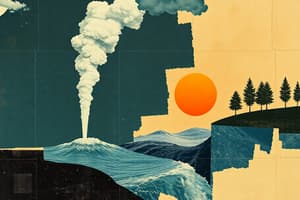Podcast
Questions and Answers
Which gas makes up the majority of the Sun's composition?
Which gas makes up the majority of the Sun's composition?
- Nitrogen
- Hydrogen (correct)
- Oxygen
- Helium
Mercury is classified as a gas planet.
Mercury is classified as a gas planet.
False (B)
What is the term for the curved path of an object as it moves around another object?
What is the term for the curved path of an object as it moves around another object?
orbit
The largest planet in the Solar System is ______.
The largest planet in the Solar System is ______.
Match the following planets with their correct categories:
Match the following planets with their correct categories:
What would happen if Earth was further away from the Sun?
What would happen if Earth was further away from the Sun?
The Sun is 150 million kilometers away from Earth.
The Sun is 150 million kilometers away from Earth.
The process by which the Sun produces energy is called ______.
The process by which the Sun produces energy is called ______.
What role does the sun play in the water cycle?
What role does the sun play in the water cycle?
Higher altitudes generally result in warmer temperatures.
Higher altitudes generally result in warmer temperatures.
Name one phase in which water exists in the water cycle.
Name one phase in which water exists in the water cycle.
The process of water molecules moving from a liquid state to a gas state due to heat from the sun is called __________.
The process of water molecules moving from a liquid state to a gas state due to heat from the sun is called __________.
Match the following processes of the water cycle with their descriptions:
Match the following processes of the water cycle with their descriptions:
Which of the following factors does NOT influence temperature?
Which of the following factors does NOT influence temperature?
Condensation is the process that occurs when water vapor rises and cools to form clouds.
Condensation is the process that occurs when water vapor rises and cools to form clouds.
What happens to water molecules during the condensation process?
What happens to water molecules during the condensation process?
Which planet is known as the 'red planet'?
Which planet is known as the 'red planet'?
Earth has a nitrogen and oxygen atmosphere.
Earth has a nitrogen and oxygen atmosphere.
What gas does Venus have in its atmosphere that contributes to its greenhouse effect?
What gas does Venus have in its atmosphere that contributes to its greenhouse effect?
The dwarf planet is called ______.
The dwarf planet is called ______.
Which planet takes the longest to complete a revolution around the sun?
Which planet takes the longest to complete a revolution around the sun?
Match the following planets with their atmospheric composition:
Match the following planets with their atmospheric composition:
Saturn is classified as a terrestrial planet.
Saturn is classified as a terrestrial planet.
How many Earth days does it take Mercury to orbit the sun?
How many Earth days does it take Mercury to orbit the sun?
Flashcards are hidden until you start studying
Study Notes
Temperature
- Temperature influences life on Earth and is affected by sunlight, altitude, water bodies, and ocean currents.
- Polar regions are cold, and tropical regions are hot, determined by sunlight's distance from Earth.
Water
- Crucial for survival of plants and animals.
- Amount, frequency, and distribution of water influence plant and animal distribution.
- Exists in three phases: liquid (oceans, rivers, lakes), gas (water vapor), and solid (polar ice caps, icebergs).
- The water cycle is driven by the sun and involves evaporation, transpiration, condensation, precipitation, runoff, and collection.
The Solar System
- Composed of the sun, planets, moons, asteroids, comets, and meteoroids.
- The sun is a medium-sized star that produces its own energy.
- It's the central and largest body, with planets, moons, asteroids, comets, gas, and dust orbiting around it.
- Responsible for Earth's weather and climate.
The Sun
- A burning sphere composed of 75% hydrogen gas and 25% helium gas.
- Temperatures within the sun can reach 15 million degrees Celsius.
- Nuclear fusion occurs within the sun, releasing vast amounts of heat and energy.
- The photosphere provides the right temperature for Earth.
- If Earth were closer or farther away from the sun, temperatures would be too high or too low, making life impossible.
- Only a small fraction of the sun's energy reaches Earth.
Objects Around The Sun
- Our solar system includes 8 planets (and their moons), dwarf planets, asteroids, comets, gas, and dust.
- All objects in the solar system have unique characteristics, including size, distance from the sun, number of moons, composition, surface temperature, and orbital period.
The Planets
- Classified into inner (rocky) and outer (gas) planets.
- Inner planets: Mercury, Venus, Earth, Mars.
- Outer planets: Jupiter, Saturn, Uranus, Neptune.
Solid Planets
- Mercury: Solid planet with tiny amounts of hydrogen and helium, 58 million km from the sun, has an orbital period of 88 Earth days.
- Venus: Spins opposite to other planets, has CO2 and sulphuric acid clouds, 108 million km from the sun, has an orbital period of 255 Earth days.
- Earth: Only planet known to sustain life, has nitrogen and oxygen in its atmosphere, 150 million km from the sun, has an orbital period of 365.25 Earth days.
- Mars: Known as the "red planet" due to dust, has carbon dioxide, nitrogen, and argon in its atmosphere, 249 million km from the sun, has an orbital period of 687 Earth days.
Gas Giants
- Jupiter, Saturn, Uranus, Neptune are large planets consisting primarily of hydrogen and helium.
- They are also known as "Jovian planets".
Studying That Suits You
Use AI to generate personalized quizzes and flashcards to suit your learning preferences.




